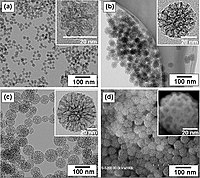
Photo from wikipedia
Abstract Silicon oxide nanocluster suspensions were drop-cast on highly oriented pyrolytic graphite (HOPG) and investigated using ultra-high vacuum non-contact atomic force microscopy (AFM). The assembly of silicon oxide nanoparticle arrays… Click to show full abstract
Abstract Silicon oxide nanocluster suspensions were drop-cast on highly oriented pyrolytic graphite (HOPG) and investigated using ultra-high vacuum non-contact atomic force microscopy (AFM). The assembly of silicon oxide nanoparticle arrays was observed during consecutive scanning of the surface using AFM. The patterns and alignments of the nanoparticle arrays were consistent with templating on a Moire pattern in the top layers of the HOPG substrate. By halting and restarting the scanning process it was shown that the formation of nanoparticle arrays was driven by the AFM scan itself. Vacancy defects identified within the nanoparticle arrays were found to fill over time with nanoparticles; it was demonstrated that diffusion was preferred along the symmetry lines. This ‘self-healing’ mechanism was also shown to be driven by the AFM scanning. The recovery of defects within the arrays, and other observations of array dynamics, implied that the nanoparticle arrays had liquid-like qualities.
Journal Title: Surface Science
Year Published: 2019
Link to full text (if available)
Share on Social Media: Sign Up to like & get
recommendations!